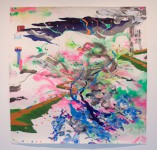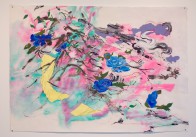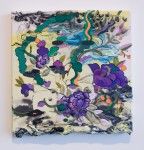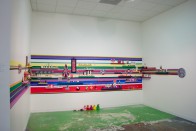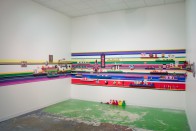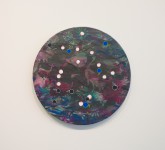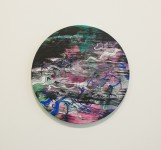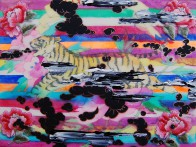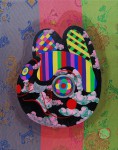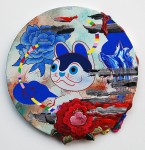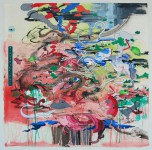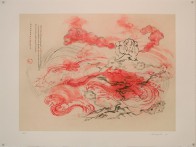BLUE PEONY AND IMPURE THOUGHTS
January 23, 2010 - March 6, 2010
- Jiha Moon
Throughout her artistic career, the multivalent paintings of Korea-born and Atlanta-based artist Jiha Moon have operated in several distinctive yet visually cohesive realms. As the title of her current Saltworks Gallery exhibition—“Blue Peony and Impure Thoughts”—suggests, this handsome body of work simultaneously conflates cultural references and confounds expectations, all while accommodating multiple audience interpretations.
For a new viewer of Moon’s work, initially, these swirling, mythical landscapes—boldly colored and finely detailed—appear tightly focused, paying homage to traditional Asian artistic styles and techniques. While present, through sustained looking, subversion and Western influence becomes equally apparent. The visual complexity in each painting is plain; even large, multi-hued plumes of paint are veiled with systems of thin, sinewy lines, such as in Painter’s Argument. Yet Moon’s ultimate goal is not to impress through pristine beauty. Layers of strange figures come into view: disembodied limbs, computer icons, or fanged, Pacman-like creatures.
The unnatural abounds in everyday life and in Moon’s compositions, like the blue peony, found in Cheoyong and others. Traditional pink or white peonies represent luxury and wealth—the opposite of lotuses, which signify spirituality—but blue peonies don’t exist in nature, twisting the expectation of these signature shapes. In this spirit, another shifting character in her work is an inu-hariko, another symbol for good fortune, which looks like a cat, but is actually a dog found on traditional Japanese toys and sweets like Botan Rice Candy (botan means peony in Japanese). Therefore, these lush surfaces have deeper, changeable underpinnings, as the “true” identities of each figure fades in and out of focus.
Moon experiments with small- and large-scale painting, without privileging the importance of one over the other. Although she is a speedy mark maker, each surface is constantly reworked, allowing for surprising structures to be created or canceled out. Uniquely, the experimentation in this exhibition spills off the Hanji paper (her typical surface) and onto one room’s walls, which are painted in rainbow stripes meant to echo a ubiquitous and often ceremonial Korean silk design. There are intimately-sized panels and tondos hung in this section, in addition to little shelves housing Moon’s personal collection of toys, souvenirs from recent travels, and projects by artist friends. This installation creates a visual form for an artist’s vast storehouse of images; here, inspirational elements of the studio and mind take center stage.
Moon has pursued spaces beyond the painting’s edge in other ways as well. Specifically evident here is a long-standing admiration of Philip Guston (1913-1980), particularly his painting styles and philosophies. Moon’s increasingly tactile surfaces draw from Guston’s thick oil paint application; instead, it is achieved through such means as embroidery or overpainting with matte medium. Guston had an innate ability to accept the chaotic; he made drastic, stylistic shifts—representational, abstract, figurative—at times facing consternation from his peers for doing so. As Guston described, in a quote referenced in this exhibition’s title and driving force, “…painting is “impure”. It is the adjustment of impurities which forces painting’s continuity.”
Exhibition essay by Stephanie Greene
